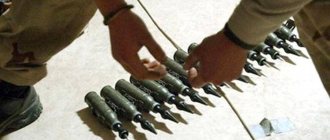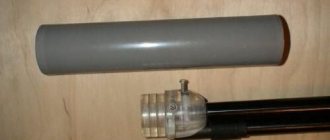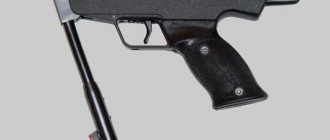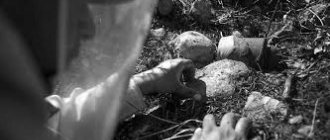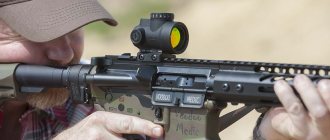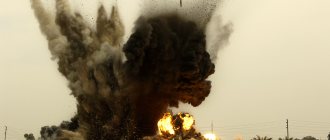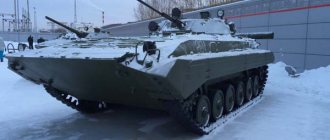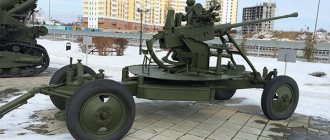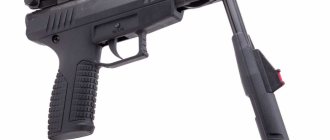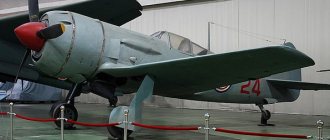Start of design work
In the mid-1970s, the Soviet Union began to develop 30-mm ammunition, which was later planned to be used as an interspecific weapon. In other words, such a cartridge could be equipped with 30-mm rifle systems used by the ground forces, navy and air force. Initially, the cartridge was listed under the symbol AO-18. The shot pressure was 3600 atm. However, according to experts, this unified ammunition did not fully comply with the stated requirements of the military command for guns. For this reason, there was a need for a new automatic gun, which became the 30 mm 2A42.
About the creation of a new weapon
The design of the 30 mm 2A42 automatic cannon was carried out by employees of the Tula Design Bureau. Led by V. P. Gryazev and A. G. Shipunov. In 1978, the first prototype of an artillery gun was ready. Later, the leadership of the USSR decided that the serial production of guns should be carried out at this enterprise.
The gun's automation uses the energy of powder gases, which are discharged from the barrel. For this purpose it was equipped with a special side hole. In an effort to reduce the rather powerful recoil, the designers dampened the barrel. In addition, it is provided for its rollback by 3.5 cm during a shot. In order to make it easier to supply belts with ammunition to the gun, it was mounted motionless on the installation. Due to the fact that the new automatic gun was initially intended for infantry and airborne combat vehicles, the idea of using the gun in helicopters was met with skepticism. Some experts believed that using the 2A42 on a helicopter was not advisable.
This point of view was also shared in industrial institutes. That is why, while working on a gun for the Ka-50 helicopter, employees of the Design Bureau named after. Kamov paid especially much attention to the entire structure. Since the helicopter fed the single-barrel gun with cartridge belts from both sides, the fighters had the opportunity to equip the gun with the required type of ammunition (armor-piercing or incendiary high-explosive fragmentation) depending on the target that was to be destroyed. This design feature made it possible to save transported combat kit.
30-mm automatic guns: decline or a new stage of development?
Around the middle of the 20th century, the 30 mm caliber became the de facto standard for automatic guns. Of course, automatic guns of other calibers, from 20 to 40 mm, also became widespread, but the 30 mm caliber still became the most widely used. Rapid-firing 30 mm caliber guns are especially widespread in the Armed Forces of the USSR/Russia.
The scope of application of 30 mm automatic guns is enormous. These are aircraft guns on fighters, attack aircraft and combat helicopters, rapid-fire guns on infantry fighting vehicles (IFVs) and short-range air defense systems, and short-range air defense systems on surface ships of the Navy.
The main developer of 30-mm automatic guns in the USSR/Russia is the Tula Instrument Design Bureau (KBP). It was from this that such wonderful 30 mm automatic cannons came out as the 2A42 product, installed on the BMP-2 and the Ka-50/52, Mi-28 helicopters, this and the 2A72 product, installed in the BMP-3 turret module, together with a 100 mm gun and 12.7 mm machine gun, rapid-fire double-barreled guns 2A38, mounted on anti-aircraft gun-missile systems (ZPRK) "Tunguska" and "Pantsir", aviation GSh-301 for Su-27 and MIG-29 aircraft, ship-based six-barreled AO-18 (GSh -6-30K) and other models.
30-mm cannon 2A42 - probably the Kalashnikov Avtomat among automatic guns
- caliber: 30 mm, cartridge - 30×165 mm; — length: 3027 mm; — total weight: 115 kg; — rate of fire is variable: 550-800 rounds/min. or 200-300 rounds/min; — gun power supply: two-belt (selective ammunition supply); — barrel survivability: 9000 shots; — effective firing range against manpower: up to 4000 m; — effective firing range for lightly armored vehicles: up to 1500 m; — effective firing range at air targets: up to 2000 m / 2500 m.
At the same time, in the 21st century, complaints about 30 mm automatic guns began to appear. In particular, armored combat vehicles of the ground forces (ground forces) began to be equipped with enhanced armor protection, capable of withstanding fire from 30 mm cannons in the frontal projection. In this regard, words began to be heard about the transition to automatic guns of 40 mm caliber or more. In Russia, you can increasingly see samples of armored vehicles with a 57 mm 2A91 automatic cannon, developed by the Burevestnik Central Research Institute.
BMP-3, equipped with an AU-220M combat module, with a 57 mm automatic cannon
— length: 5820 mm, width: 2100 mm, height: 1300 mm; — cartridge: 57×348 mm SR; — gun rate of fire: 120 rounds/min; — firing range: 12,000 m; — ammunition: 80 shells.
At the same time, as the caliber increases, the ammunition capacity is radically reduced. If for the 30-mm gun of the BMP-2 the ammunition load is 500 shells, then for the 57 mm gun of the AU-220M module, which can be installed on both the BMP-2 and the BMP-3, the ammunition load is only 80 shells. The weight and size characteristics of the modules, with 57 mm caliber guns, do not always allow them to be placed on compact armored vehicles. It is also unlikely that it will be possible to install a 57 mm cannon on a helicopter or airplane, even if you place it close to the center of mass, as on the Ka-50/52, or build the aircraft “around the cannon,” like the American A-10 Thunderbolt II attack aircraft.
Automatic 30-mm seven-barreled gun of the A-10 Thunderbolt II attack aircraft
In aviation, the very need to install an automatic cannon is often questioned. A significant increase in the power of radar and optical location stations (radar and OLS), the improvement of long-, medium- and short-range air-to-air missiles, in combination with all-aspect guidance systems, minimize the likelihood that the situation in the air will reach a “dog dump” ", i.e. maneuverable air combat using automatic guns. Reduced visibility and electronic warfare (EW) technologies are unlikely to change this situation, since in any case, the growth in the capabilities of modern radars and OLS will most likely make it possible to detect and attack aircraft with stealth technology beyond the range of automatic guns.
At present, automatic cannons on multirole fighters remain rather due to a certain conservatism of the air force (Air Force).
For combat helicopters, the use of an automatic cannon means entering the kill zone of short-range hand-held air defense systems of the Igla/Stinger type, anti-tank guided missiles (ATGMs) and small arms and cannon weapons of ground combat vehicles.
The use of automatic guns as part of ground-based anti-aircraft missile systems also raises questions. As part of one complex, automatic cannons are used on Soviet/Russian air defense missile systems "Tunguska" and "Pantsir". According to the results of the military operations in Syria, all real combat targets were shot down by missiles, and not by automatic guns. According to some reports, automatic 30 mm guns do not have the accuracy and accuracy sufficient to hit small targets, such as an unmanned aerial vehicle (UAV) or guided/unguided ammunition.
Table of targets hit by the Pantsir S1 air defense system in Syria
This leads to the fact that often the cost of a downed target exceeds the cost of an anti-aircraft guided missile (SAM) fired at it. Large targets, such as an airplane or helicopter, are tried not to fall within the range of action of automatic guns.
A similar situation is developing in the navy. If subsonic anti-ship missiles (ASMs) can still be hit by multi-barreled automatic cannons, then the probability of hitting supersonic maneuvering anti-ship missiles is significantly lower, not to mention hypersonic anti-ship missiles. In addition, the high approach speed and significant mass of a supersonic/hypersonic anti-ship missile can lead to the fact that even if it is hit at a short distance from the ship, the remains of the dilapidated anti-ship missile will reach the ship and cause significant damage to it.
To summarize the above, it may turn out that in Russia, in the ground forces on infantry fighting vehicles, 30 mm automatic cannons are highly likely to be replaced by automatic cannons of 57 mm caliber; on airplanes, most of the time, an automatic cannon takes up space for nothing; in anti-aircraft missile systems complexes of both the ground forces and the Navy, the role of 30 mm automatic guns is also decreasing, which may lead to a gradual abandonment of them and replacement with air defense systems of the RIM-116 type. Could this lead to the gradual oblivion of 30 mm weapons, and what areas of development and areas of application do quick-firing guns of this caliber have?
The use of 57 mm automatic cannons on infantry fighting vehicles does not mean that there is no place for their 30 mm counterparts on other types of ground combat equipment. In particular, the NGAS company presented the concept of installing modules with the M230LF cannon on armored vehicles, small-sized robotic systems and other vehicles, as well as stationary structures, as a replacement for 12.7 mm machine guns.
M230LF 30mm automatic cannon on an armored vehicle
Automatic gun M230LF 30 mm caliber on a ground-based remote-controlled robotic complex
Automatic cannon M230LF 30 mm caliber on a stationary turret
Similar remote-controlled weapon modules (RCWM), for use on light armored vehicles and ground-based robotic systems, can also be developed on the basis of Russian 30 mm automatic guns. This will significantly expand the scope of their application and sales market. The significant recoil of 30 mm guns can be reduced by limiting the rate of fire of automatic 30 mm guns to 200-300 rounds/min.
An extremely interesting solution could be the creation of compact remote-controlled weapon modules based on 30 mm guns, for use on main battle tanks, as a replacement for the 12.7 mm anti-aircraft machine gun.
It is worth noting that the issue of equipping tanks with a 30 mm caliber auxiliary gun was repeatedly considered both in the USSR/Russia and in NATO countries, but the matter never reached large-scale production. For T-80 tanks, an installation with a 30-mm 2A42 automatic cannon was created and tested. It was intended to replace the Utes machine gun and was mounted in the upper rear part of the turret. The gun's pointing angle is 120 degrees horizontally and -5/+65 degrees vertically. The ammunition load was supposed to be 450 shells.
Experimental version of placing a 30-mm 2A42 cannon on a T-80 tank (photo by Dmitry Semenov)
A promising 30-mm remote-controlled weapon module should have all-round horizontal visibility and a large vertical guidance angle. The power of a 30-mm projectile, compared to a 12.7 mm caliber bullet, combined with maximum visibility from the roof of a tank turret, will significantly increase the tank’s ability to combat tank-dangerous targets, such as grenade launchers and armored vehicles with ATGMs, and enhance the ability to defeat aircraft enemy means of attack. Massive equipping of DUMV tanks with 30 mm cannons can make such a class of armored vehicles as the tank support combat vehicle (BMPT) unnecessary.
Another promising area for using 30 mm guns as part of tank armament could be joint work with the main gun when hitting enemy tanks equipped with active protection systems (APS). In this case, it is necessary to synchronize the operation of the main gun and the 30 mm cannon in such a way that when firing at an enemy tank, a burst of 30 mm shells is fired a little earlier than the firing of an armor-piercing discarding sabot (APS) projectile from the main gun. Thus, being hit by 30-mm shells initially leads to damage to the active protection elements of the enemy tank (detection radar, containers with striking elements), which allows the BOPS to hit the tank without hindrance. Shooting, of course, must be carried out in an automated mode, i.e. The gunner points the crosshairs at the enemy tank, selects the “anti-KAZ” mode, presses the trigger, and then everything happens automatically.
The option of equipping 30 mm shells with some aerosol or other filler and a fuse with remote detonation may also be considered. In this case, a burst of 30 mm shells detonates in the active protection zone of the enemy tank, interfering with the operation of its radar detection equipment, but without interfering with the flight of the BOPS.
Another direction for developing the scope of application and increasing the efficiency of 30 mm automatic guns is the creation of projectiles with remote detonation along the flight path, and in the future the creation of controlled 30 mm projectiles.
Projectiles with remote detonation have been developed and implemented in NATO countries. In particular, the German company Rheinmetall offers a 30 mm air blast projectile, also known under the designation KETF (Kinetic Energy Time Fused - kinetic with a remote fuse), equipped with an electronic timer programmed by an inductive coil in the muzzle.
In Russia, 30-mm projectiles with remote detonation on the trajectory were developed by the Moscow NPO Pribor. Unlike the inductive system used by Rheinmetall, Russian projectiles use a remote detonation initiation system using a laser beam. Ammunition of this type will be tested in 2022 and in the future should be included in the ammunition of the latest combat vehicles of the Russian army.
The use of projectiles with remote detonation along the flight path will increase the capabilities of air defense systems equipped with 30-mm automatic cannons to combat small-sized and maneuvering targets. The air defense of ground combat vehicles equipped with 30 mm automatic cannons will be strengthened in the same way. The ability to defeat enemy personnel in open areas will increase. This is especially important for tanks, if they are equipped with a DUMV with a 30 mm automatic cannon.
The next step could be the creation of guided projectiles in 30 mm caliber.
Currently, there are developments of 57 mm caliber guided projectiles. In particular, BAE Systems Corporation at the Sea-Air-Space 2015 exhibition for the first time presented a new 57-mm ORKA (Ordnance for Rapid Kill of Attack Craft) guided projectile, designated as Mk 295 Mod 1. The new projectile is designed for firing from 57-mm mm of ship-based universal automatic artillery installations Mk 110. The projectile must have a two-channel combined homing head - with a semi-active laser channel (guidance is carried out using external laser target designation) and an electro-optical or infrared channel that uses memory of the target's appearance.
BAE Systems' 57mm ORKA guided projectile under development
According to some reports, Russia is also developing a 57 mm caliber guided projectile for the Air Defense Derivation anti-aircraft module. The development of the guided projectile is carried out by the Tochmash Design Bureau named after A. E. Nudelman. The developed guided artillery projectile (UAS) is stored in an ammunition rack, launched from a rifled gun barrel and guided by a laser beam, which makes it possible to hit targets in a wide range of ranges - from 200 m to 6...8 km for manned targets and up to 3...5 km for unmanned ones .
The UAS airframe is made according to the canard aerodynamic configuration. The tail of the projectile consists of four rudders placed in a sleeve, which are deflected by a steering gear located in the nose of the projectile. The drive operates from the incoming air flow.
The UAS is fired with a high initial speed and almost immediately has the lateral accelerations necessary for guidance. The projectile can be fired towards the target or towards the calculated lead point. In the first case, guidance is carried out using the three-point method. In the second case, guidance is carried out by adjusting the trajectory of the projectile. In both cases, the projectile is teleoriented in a laser beam (a similar control system is used in the Kornet ATGM of the Tula KBP). The photodetector of the laser beam aimed at the target is located in the end part and is covered with a tray, which is separated in flight.
Anti-aircraft 57-mm UAS: 1 – protective cap, 2 – centering belt, 3 – sleeve, 4 – steering gear, 5 – non-contact radio target sensor, 6 – explosive, 7 – tail
Is it possible to create guided projectiles in 30 mm caliber? Of course, this will be much more difficult than developing a UAS in 57 mm caliber. A 57 mm caliber projectile is essentially closer to 100 mm caliber projectiles, for which guided ammunition was created quite a long time ago. Also, the use of 57 mm UAS is most likely planned in single firing mode.
Nevertheless, there are projects to create guided weapons in significantly smaller dimensions, for example, a guided 12.7 mm caliber cartridge. Such projects are being developed both in the USA, under the auspices of the well-known DARPA, and in Russia.
Thus, in 2015, the US Department of Defense tested promising EXACTO bullets with a controlled flight path. Bullets developed under the Extreme Accuracy Tasked Ordnance program will be used in a new high-precision sniper system consisting of a rifle, a special optical sight and guided cartridges. Technical details about the ammunition are not disclosed. According to unconfirmed reports, the pool contains a small battery, a microcontroller, a laser sensor and folding handlebars. After the shot, the microcontroller is activated and begins to guide the bullet to the target using the released air rudders. According to other information, flight correction is carried out by deflecting the toe of the bullet. The guidance system is presumably telecontrol in a laser beam.
Presumably this is what the Exacto guided bullet looks like
According to information from the Russian Foundation for Advanced Research (FPI), Russia has also begun testing a “smart bullet” in controlled flight mode. At the same time, it was suggested that a 30 mm ammunition could be taken as a basis, which could accommodate a control unit, a source of motion, a stabilizer unit and a warhead. However, according to the latest data, Russia has postponed indefinitely the project to create guided bullets capable of adjusting their flight. This is not necessarily due to the technical impossibility of creating them; often the limiting factor is the financial factor or a change in priorities.
And finally, the closest project in relation to the 30 mm guided projectile we are interested in is the Raytheon project - MAD-FIRES (Multi-Azimuth Defense Fast Intercept Round Engagement System - Multi-Azimuth Defense, Fast Intercept and All-round Attack System). The MAD-FIRES project is an attempt to combine the precision of missiles with the "let's shoot more of them because they're cheap" approach. The projectiles must be suitable for firing from automatic cannons of caliber from 20 to 40 mm, while MAD-FIRE ammunition must combine the accuracy and controllability of missiles with the speed and rate of fire of conventional ammunition of the corresponding caliber.
MAD-FIRES guided missile
Based on the above examples, it can be assumed that the creation of guided munitions in 30 mm caliber is a quite feasible task for both the Western and Russian military-industrial complex (MIC). But how necessary is this? It goes without saying that the cost of guided projectiles will be significantly higher than the cost of their unguided counterparts, and higher than the cost of projectiles with remote detonation along the trajectory.
Here it is necessary to consider the situation as a whole. For the armed forces, the determining criterion is cost/effectiveness, i.e. if we hit a tank worth $10,000,000 with a $100,000 missile, then this is acceptable, but if we hit a $100,000 missile with a jeep with a heavy machine gun, worth $10,000 in total, then this is not very good. However, there may be other situations, for example, when a $100,000 anti-aircraft missile intercepted a $2,000 mortar shell, but thanks to this, a $100,000,000 plane at the airfield was not destroyed, and the pilot and maintenance personnel were not killed. In general, the issue of cost is a multifaceted issue.
In addition, the development of technologies makes it possible to optimize the production of many components of promising products - high-precision casting, additive technologies (3D printing), MEMS technologies (microelectromechanical systems) and much more. It’s difficult to say now what the cost of a 30 mm guided projectile will ultimately be that developers/manufacturers can get – $5,000, $3,000, or maybe just $500 apiece.
Let's consider the impact of the appearance of guided 30 mm projectiles on increasing the efficiency and expanding the scope of application of rapid-fire guns.
As mentioned earlier, in aviation, maneuverable combat with the use of guns has become extremely unlikely. On the other hand, it is extremely important to create a kind of “active protection” of the aircraft from attacking missiles. In the West, they are trying to solve this problem by creating highly maneuverable CUDA interceptor missiles, developed by . Such missiles will not harm our country either.
CUDA interceptor missile
As a means of active protection against attacking missiles, one can also consider the use of 30 mm guided projectiles with remote detonation along the trajectory. The ammunition load of a modern fighter is about 120 pieces. 30 mm shells. Replacing existing standard ammunition with guided 30 mm projectiles with remote detonation will make it possible to conduct high-precision fire at enemy air-to-air or surface-to-air guided missiles on oncoming courses. Of course, this will require retrofitting aircraft with an appropriate guidance system, including 2-4 laser channels to ensure simultaneous attacks on several targets.
If a maneuverable air battle does take place, an aircraft with 30 mm guided projectiles will have an undeniable advantage due to the greater effective firing range, the absence of the need to accurately orient the aircraft's fixed gun at the enemy, and the ability to compensate, to some extent, for enemy maneuvers by adjusting the flight trajectory of the fired missiles. shells.
Finally, when solving such a problem as repelling an attack by long-range high-precision cruise missiles (CR), the pilot, after exhausting the missile ammunition, can spend several guided 30 mm projectiles on one conventional “Tomahawk”, i.e. one fighter can destroy an entire salvo of missiles from any Virginia-class submarine, or even two.
Similarly, the use of guided 30-mm projectiles in the air defense weapons of a surface ship will make it possible to push back the limit of destruction of anti-ship missiles. Now for the Kashtan anti-aircraft missile and gun system (ZRAK), official sources indicate the zone of destruction by artillery weapons at a range of 500 to 1.5 thousand m, but in fact, the destruction of anti-ship missiles is carried out at the turn of 300-500 m, at a range of 500 m, the probability of hitting the Harpoon anti-ship missile is 0.97, and at a distance of 300 m it is 0.99.
The use of 30 mm guided projectiles, like the use of any guided weapon, will increase the likelihood of hitting anti-ship missiles at a significantly greater distance. This will also make it possible to reduce the size of ship artillery installations by reducing the ammunition load and abandoning the monstrous “Duet” type products.
Shipborne dual-automatic 30-mm automatic artillery mount "Duet"
The same can be said about the use of guided 30 mm projectiles in land air defense systems. The presence of 30 mm guided projectiles in the Pantsir ammunition will allow saving missile weapons when hitting subsonic precision-guided ammunition, leaving missiles for the carrier aircraft, which will reduce the likelihood of a repetition of the situations that occurred in Syria, when air defense systems with spent ammunition were destroyed with impunity.
From an economic point of view, destroying mortar mines and balloons with 30 mm guided projectiles should also be cheaper than with anti-aircraft missiles.
Finally, the use of guided 30-mm projectiles in the ammunition load of ground vehicles and combat helicopters will make it possible to destroy targets from a greater range, with a significantly higher probability and with less ammunition consumption. If you have high-quality sighting devices, it will be possible to work on the enemy’s vulnerable points - surveillance devices, areas of weakened armor, air intake filters, exhaust system elements, and so on. For a tank with a 30 mm DUMV, the presence of guided ammunition will allow you to more accurately hit elements of the active protection of an enemy tank, and work against attacking helicopters and UAVs with a high probability of hitting the target.
The Russian 2A42 and 2A72 guns have an important advantage over many others - the presence of selective ammunition from two shell boxes. Accordingly, one box can contain guided 30 mm ammunition, and another can contain conventional ammunition, which will allow you to select the necessary ammunition based on the situation.
The use of 30-mm guided projectiles in the interests of all types of Russian armed forces will reduce the cost of an individual projectile due to the mass production of standardized components.
Thus, we can formulate a conclusion - the following development directions will extend the life cycle of high-speed automatic guns of 30 mm caliber:
1. Creation of the lightest and most compact combat modules based on 30-mm guns.
2. Massive introduction of shells with remote detonation along the flight path.
3. Development and implementation of 30 mm caliber guided projectiles.
Device
The 30 mm gun consists of the following main components:
- Trunk.
- Breech.
- Butt plate.
- Buttplate axles.
- Electric descent.
- Contactor.
- Receiver.
- Springs.
- Bolt frame.
The Kamovites attached a plate with the following parts on it to the gun pullers using four screws:
- A special guide for the carriage in the form of feed fingers.
- A bar whose task is to guide the cartridge during feeding from the belt and hold the axis of the fingers, preventing them from falling out.
- A special stop that guides the cartridge and turns off the lever feed latch.
The task of the receiver is to direct the movement of the entire bolt group. Also on the box are placed and connected all the components and spare parts of the gun. The receiver is represented by the box itself, counter slopes, cassettes: two front and two rear, two side cartridge clamps, 2 guide links, a latch, a reflector and a rod.
The receiver is a stamped steel structure. The bolt release is released using the reloading guide. Strips (2 pcs.) are used as stops for the spring. In an effort to increase the rigidity of the box, the structure was equipped with two liners and a plate. The cassettes are fastened using a bracket.
The front and rear pullers guide the cartridge strip. In order to prevent the ammunition from moving from the line along which they are sent into the gun, the rear pullers were equipped with special rods with flags. After firing, use the switch to release the latch and turn the flag. As a result, the cartridge is removed from the feed line.
Ammunition
By the beginning of the 2000s. RWM Rheinmetall Waffe und Munition, formerly Oerlikon, developed a cartridge with a RMS303 finned sabot projectile for the 30-mm 2A42 and 2A72 guns, using Swiss technology for constructing a plastic pallet[7] from a composite based on a heat-resistant thermoplastic polymer. The BOPTS of the RMC303 cartridge is an adapted version (to the domestic 30×165 mm case of smaller volume) of the PMC287 finned projectile of the standard 30×173 mm NATO cartridge due to a corresponding reduction in the size and weight of the flight part[8]. The initial speed of a feathered projectile weighing 195 g is 1325 m/s, armor penetration is 47 mm (rolled steel homogeneous armor (English) Russian) at an angle of 60° at a distance of 1 km.
In 2005, the Belgian company Mecar (currently a subsidiary of The Allied Defense Group, USA), which has experience in creating sub-caliber projectiles with an armor-piercing core of increased elongation in calibers from 25 to 120 mm, developed a new 30-mm cartridge M929 with BOPTS for 2A42 guns and 2A72[9]. In terms of armor penetration parameters, the M929 ammunition is superior to similar 30-mm Oerlikon cartridges PMC303 and IHLA (Slovakia). Thanks to the increased elongation of the M929 core and the presence of a rotating belt, the following armor penetration indicators were achieved: 55 mm/60°/1000 m and 45 mm/60°/2000 m. The shown armor penetration parameters of the Belgian ammunition, apparently being the maximum for the system, are used in the West in as initial data when analyzing the effectiveness of 30-mm 2A42 and 2A72 cannons against armored targets[10][11].
| Ammunition nomenclature [12][13][14] | |||||||
| Shot index | Manufacturer country | Projectile mass, g | Explosive mass, g | Shot weight, g | Initial projectile speed, m/s | Average maximum pressure of powder gases, kg/cm² | Armor penetration, mm/m[sn 1] |
| Armor-piercing | |||||||
| 3UBR6 | Russia, Russia | 400 | — | 858 | 970 | 3600 | 20/700 |
| 3UBR8 | Russia, Russia | 304 | — | 765 | 1120 | 3600 | 27/1000 |
| M929 | Belgium Belgium | — | 1275К:Wikipedia:Articles without sources (type: not specified) [ source not specified 2062 days ] | ||||
| AP-T BT | Bulgaria Bulgaria | 400 | — | 853 | 960—980 | ||
| IHLA | Slovakia Slovakia | 185 | — | 650 | 1370 | 100/150 | |
| AP-T | Czech Republic Czech Republic | — | 18/1000 | ||||
| PMC 303 | Switzerland Switzerland | 195 | — | 663 | 1325 | ||
| PMC 304 | Switzerland Switzerland | 235 | — | 1220 | |||
| High explosive fragmentation incendiary | |||||||
| 3UOF8 | Russia, Russia | 389 | 49 | 837 | 960 | no more than 3600 | — |
| HE-T OT | Bulgaria Bulgaria | 389 | 118 | 833 | 940—960 | — | |
| JOSv HE-T | Slovakia Slovakia | — | |||||
| Fragmentation tracers | |||||||
| 3UOR6 | Russia, Russia | 385 | 11,5 | 830 | 960 | no more than 3600 | — |
| HE-I OFT | Bulgaria Bulgaria | 123 | 833 | 960 | — | ||
| Table of armor penetration of armor-piercing ammunition of the 2A42 gun | ||||||
| Projectile / Distance, m | 100 | 200 | 500 | 1000 | 1500 | 2000 |
| Solid-body BT 30×165 mm index 3UBR6 | ||||||
| (tilt angle 60°, homogeneous armor) | 40 | 35 | 25 | 18 | 15 | 10 |
| BP 30×165 mm index 3UBR8 | ||||||
| (tilt angle 60°, homogeneous armor) | 45 | 40 | 33 | 28 | 25 | 22 |
| BOPS 30×165 mm Oerlikon PMC303 | ||||||
| (tilt angle 60°, homogeneous armor) | 51 | 47 | 43 | 38 | ||
| Armor penetration at an angle of 60° (from the normal to the armor surface) is indicated in the thickness of rolled steel armor. For the Russian Federation - high-hardness steel armor, for NATO - medium-hardness armor. | ||||||
About transportation
The 2A42 automatic cannon is equipped with armored infantry fighting vehicles BMP-2, airborne assault vehicles BMD-2 and BMD-3, armored personnel carriers BTR-90 and BMPT. The Ka-50 combat helicopters are also equipped with 2A42. In addition, employees of the South African branch of BEA Systems Corporation developed and successfully tested the TRT-R30 controlled turret. Using this combat module you can also install a 2A42 automatic cannon on an armored vehicle.
About ammunition
From the very beginning to this day, the gun has been equipped with three types of cartridges:
- Armor-piercing tracer. In technical documentation they are designated by the abbreviation BT.
- High-explosive fragmentation with incendiary mixture (OFZ).
- Fragmentation tracers (FRT).
In the 1980s, it turned out that solid-body armor-piercing shells were ineffective when used with the basic NATO Marder-1 infantry fighting vehicles with a mass of 29.2 tons, and the 22.6-ton Bradley.
TTX
- The 2A42 automatic cannon is a small-caliber single-barrel gun.
- It entered service with the Soviet army in 1980.
- Shooting is carried out with a 30x165 mm cartridge.
- Caliber 2A42 – 30 mm.
- During firing, energy of 150-180 kJ is generated.
- The total length of the gun is 302.7 cm, the barrel is 240 cm.
- The barrel is equipped with 16 rifling. The pitch length is 715.5 mm.
- The barrel weighs no more than 38.5 kg.
- The mass of the entire gun is 115 kg.
- Within one minute, you can fire from 550 to 800 shots.
- The fired projectile moves at a speed of 970 m/s.
- The recoil generated during firing is 40-50 kN.
b MYUVYUKE 1972 Ts. THPLYU Hughes Helicopters MYUVYUKYU MEGYUBHYAHLSCH OPNTsPYULLS HYAYAKEDNBYUMKH YANGDYUMKH 20-LL NDMNYARBNKEMNI OSYKH I BMEMHL OPHBNDNL. mNBYU OSYU YANGDUBUKYUYAE OND ANEOPHOYUYASH YEPHH l50 X DNKFMYU ASHKYU HYAONKEGNBURE AEGGBBEMEEBSC YAHYARELS OKHRYUMHЪ X TSMYZHNMHPNBURE GY YAVER BMEMETSN KHYARNVMHYU SHME PTsKHKH, B RN BPEL YUY ANKEHMYARBN YUBRNLYURHVEYAYKHU AXIS HYAONKEGSCHR SHMEPTSKHCH ONPNUNBSHU TSYUGNB. b 1972 Ts. YUPLHYYYANYARYUBHKYU RPEANBYUMHY Y OEPYAOEIRKHBMNLS SDYUPMNLS BEPRNKERS ON OPNTsPYULLE AAH (Advanced Attack Helicopter). b SCHRKHU RPEANBYUMKHU ASHKYU SYUGYUMYU 30-LL YUPRHKKEPKHIYYU YAHYARELYU, YAONYANAMYU BEYARKH YARPEKEAS YAMYUPDNL WECOM 30. b YNMYSPYAE MU PYUGPYUANRYS BEPRNKERYU AAH ONAEDHKYU TH PLU Hughes. RYUYYYUY 20-LL YAMYUPDSH YAEPHKh l50 X 30-LL XM552/639 (WECOM 30) HLECHR YAUNFHE PUGLEPSH, MYUVYUKEMSHI KHLOSKEYA, RN ASHKN PEEMN YUDYUORKHPNBURE Y MNBSHL RPEANBYUMKH L OPYURKHVEYAYKH ONKMNYARECH GYYNMVEMMSCH 20-LL OSYS. b 1973 Ts. b 1976 Ts. st230
DNKFMYU YARPEK'RE YAMYUP'DYULH HYAONKEGSELSHLH OSYYULH ADEN /DEFA, YU RYU FE YAELEEYARBNL 30-LL YAMYUP'DNB l788 (OPYURKHVEYAYKHI), l789 (DBSUZHEKEBNI NYNKNVMN-TSTSYUYAMSHI) X l7 99 (NYAYNKNVMN-TSTSYUYAMSHI).
b 1982 Ts. YANYARNKYUYAE DELNMYARPYUZHH YNLOKEYAYU YUBKHYUZHNMMNTSN BNNPSFEMH BEPRNKERYU AH-64A Apache. I ONYARSOKEMKHEL B 1984 Ts .
ASHKYU OPKHMURYU MU BNNPSPHEMHE. ONKMNNYARECH YAKHYARELYU l230 ONKSVHKYU NANGMYUVEMHE AH-64A AWS (Area Weapon System), EE NYAMNBMSHL OPEDMYUGMYUVEMHEL OBKERYA SMKHVRNFEMKHE KETSYNAPNMHPNBYUMMNI REUMHYKH, MUGELMSHU ON ZEIRNB X BEPRNKERNB OPNRHBMHYU.
oNLHLN BEPRNKERNB Apache L230 HYAONKEGSERYA MU BEPRNKERYUU MD-500/530 Defender B YANYARYUBE YAKHYARELSH BNNPSFEMHJ HGS-30 (BEYA YAKHYARELSH 340 YTS, ANEINLOKEIR 426 YAMYUPDNB). b DUKEMEYEL MU AYUGE l230 ASHKYU YANGDYUMYU DKYUPLXX YAYU 25-LL AXYU M242 Bushmaster X 7.62-LL OSKELER EX-34.
l230 OPEDYARYUBKYER YANANI NDMNYARBNKEMSCH 30-LL OSYS I SHCHKEIRPHVEYAYHL OPHBNDNL, X YANYARNHR XG LEMEE 150 DERYUKEY. OSYU TSMYZHNMHPSER GYU YAVER SHKEIRPHVEYAYNTSN DBKHTSUREK ONYARNMMNTSN RNYU LNYNYARECH 5 K.YA. I PUANVHL MUOPFEMHEL 29 b, X MNLKHMYUKEMNI YAYNPNYARECH BPYUYEMKH 9000 NA/LHM. BYAE ONDBHFMSHE DERYUKH YABGYUMSH LEFDS YANANI, KH YUFDNE KHU DBHFEMHE VERYN PUYAOPEDEKEMN ON BPELEMH. schRN ONGBNKYER MU 100% KHGAYUBKHREYA NR NRYUGNB, UYUPYYREPMSHU DK YUBRNLYURHVEYAYKHU YUPRHKKEPHIYAYHU YAHYAREL RPYUDHZHNMMNI YAUELSH. ANKENNE BPEL GYUOHPYUMKH YARBNKYU NAEYAOEVKHBUER YARPEKEAS AEG NYAEVEY. YAYNPNYARPEKEMNYARE OSYKH YANYARYUBKYER 625±25 BSHYAR/LHM. dK BSHUNDU MU LYYYAHLYUKEMSCH YAYNPNYARPEKEMNYARE RPEASERYA 0.2 YAYEY., YU DK NYARYUMNBYKH 0.1 YAYEY. mYUVYUKEMYU YAYNPNYARE OPH YARPEKEAE URURMSHLH ANEOPHOYUYYULH YANYARYUBKER 805 L/YA. oPH BEDEMHKH NTsMYAN YAYNPNYARPEKEMNYARECH 600 BSHYAR/LHM SHKEYRPNDBHTSUREKE ONRPEAKER RNY B 150 S.
MU BEPRNKERE Apache OSYU PUGLEYEMYU MU NRYPSHRNI KETSINI YNMYARPSYZHHH OND TCHGEKFEL. TsKhDPYUBKKHYU NAEYAOEVKHBUER SYARYUMNBYE ONDBHFMNYARE B OPEDEKYU ±110° OH YUGHLSRS X +10° -60° OH BNGBSHIEMHCH. b YAKSVYUE NRYUGYU/NRYKCHVEEMKH TSKHDPNYAHYARELSH SYARYUMNBYU OND DEYARBHEL OPSFHM BNGBPYUYUERYA B ONUNDMNE ONKNFEMKHE. ONKMSHI BEY YUPRHKKEPKHIYAYNI SYARYUMNBYKH, YAMYUPFEMMNI 1200 YAMYUPYULH l789 YANYARYUBKER 684 YTS, YU OSYARNI - 265 YTS. ANPRNBYU YAKHYARELYU SOPYUBKEMKH NPSFHEL YUBRNLYURKHVEYAYKH NYASYYARBKJER YARYUAHKKHGYUZHCH SYARYUMNBYKH H BSHVHYAKER MENAUNDHLNE SOPEFDEMKHE.
YaRYUMDUPRMSHLH ANEOPHOYUYULH OSYKH l230 YULEPKHYUMYAYNTSN OPNKHGBNDYARBU ЪБКЪЧРЯЪ YAMYUPЪDSH l788, l789 X l799.
oPUYRKHVEYAYKHI YAMYUPD l788 OPEDMYUGMYUVEM DK RPEMKHPNBYKH SHCHYHOYUFEI. nM HLEER MHGYSCH YARNHLNYARE, MN ETSN AYUKKHYARHYU ONDNAMYU ANEBSHL YAMYUPYUL. dKKHMYU YAMYUPYUDYU - 199.75 LL. BEYA 352.8 C. mYUVYUKEMYU YAYNPNYARE 800 L/Ya.
TTSYUYAMSHI YAMYUPD DBNIMNTSN MYUGMYUVEEMKH l789 ЪБКЪРЯЪ НЯМНБМШЛ ANEOPHOYUYANL OSYKH M230. ETSN YNPOSYA KhGTSNRNBKEM KH GYUYUKEMMNI YARYUKKH X YAMYUP'FEM 27 Ts. YaMYUPD YAONYANAYEM OPNAKHRE 25-LL TSNLNTSEMMNI APNMH OND STSKNL 50° MU DUKEMNYARKH 500 L. dKKHMYU YAMYUPYU 199.75 LL. BEYA 350.5 C.
TSTSYUYAMSHI YAMYUPD l799 YAMYUPFUERYA 43 Ts. BGPSHBVURNTSN B-BYU.
About strengths
The 2A42 automatic cannon has the following advantages:
- Due to the variable rate of fire and selective ammunition supply, carried out from two boxes with different cartridges, the effectiveness of destruction was increased by 30%. Also, ammo consumption is more economical.
- The cannon barrel has sufficient combat survivability to release the entire ammunition load at once. At the same time, the 2A42 does not require intermediate cooling, which is important in real combat conditions.
- The gun is effective in dusty conditions, which is important when using it on combat helicopters, since during their operation they often have to operate at low altitudes with characteristic dust formations and perform autonomous deployments on unpaved sites with limited maintenance.
- Due to its high initial velocity, the fired projectile has exceptional combat accuracy and high armor penetration. From a distance of 1500 m, it can penetrate a 15-mm armored steel sheet located at an angle of 60 degrees. Manpower is affected at a distance of no more than 4 thousand meters, lightly armored vehicles - one and a half kilometers, air objects - up to 2 thousand meters.
However, unlike similar aircraft guns, the cannon has a large mass. According to military experts, this is its only disadvantage.
An excerpt characterizing the 30 mm 2A42 gun
There was no new order from the French authorities about the party of prisoners in which Pierre was, during his entire movement from Moscow. This party on October 22 was no longer with the same troops and convoys with which it left Moscow. Half of the convoy with breadcrumbs, which followed them during the first marches, was repulsed by the Cossacks, the other half went ahead; there were no more foot cavalrymen who walked in front; they all disappeared. The artillery, which had been visible ahead during the first marches, was now replaced by a huge convoy of Marshal Junot, escorted by the Westphalians. Behind the prisoners was a convoy of cavalry equipment. From Vyazma, the French troops, previously marching in three columns, now marched in one heap. Those signs of disorder that Pierre noticed at the first stop from Moscow have now reached the last degree. The road along which they walked was littered with dead horses on both sides; ragged people lagging behind different teams, constantly changing, then joined, then again lagged behind the marching column. Several times during the campaign there were false alarms, and the soldiers of the convoy raised their guns, shot and ran headlong, crushing each other, but then they gathered again and scolded each other for their vain fear. These three gatherings, marching together - the cavalry depot, the prisoner depot and Junot's train - still formed something separate and integral, although both of them, and the third, were quickly melting away. The depot, which had initially contained one hundred and twenty carts, now had no more than sixty left; the rest were repulsed or abandoned. Several carts from Junot's convoy were also abandoned and recaptured. Three carts were plundered by the backward soldiers from Davout's corps who came running. From conversations of the Germans, Pierre heard that this convoy was put on guard more than the prisoners, and that one of their comrades, a German soldier, was shot on the orders of the marshal himself because a silver spoon that belonged to the marshal was found on the soldier. Of these three gatherings, the prisoner depot melted the most. Of the three hundred and thirty people who left Moscow, there were now less than a hundred left. The prisoners were even more of a burden to the escorting soldiers than the saddles of the cavalry depot and Junot's baggage train. Junot’s saddles and spoons, they understood that they could be useful for something, but why did the hungry and cold soldiers of the convoy stand guard and guard the same cold and hungry Russians who were dying and lagged behind on the road, whom they were ordered to shoot? not only incomprehensible, but also disgusting. And the guards, as if afraid in the sad situation in which they themselves were, not to give in to their feeling of pity for the prisoners and thereby worsen their situation, treated them especially gloomily and strictly. In Dorogobuzh, while the convoy soldiers, having locked the prisoners in a stable, went off to rob their own stores, several captured soldiers dug under the wall and ran away, but were captured by the French and shot. The previous order, introduced upon leaving Moscow, for captured officers to march separately from the soldiers, had long been destroyed; all those who could walk walked together, and Pierre, from the third transition, had already united again with Karataev and the lilac bow-legged dog, which had chosen Karataev as its owner. Karataev, on the third day of leaving Moscow, developed the same fever from which he was lying in the Moscow hospital, and as Karataev weakened, Pierre moved away from him. Pierre didn’t know why, but since Karataev began to weaken, Pierre had to make an effort on himself to approach him. And approaching him and listening to those quiet moans with which Karataev usually lay down at rest, and feeling the now intensified smell that Karataev emitted from himself, Pierre moved away from him and did not think about him. In captivity, in a booth, Pierre learned not with his mind, but with his whole being, life, that man was created for happiness, that happiness is in himself, in the satisfaction of natural human needs, and that all unhappiness comes not from lack, but from excess; but now, in these last three weeks of the campaign, he learned another new, comforting truth - he learned that there is nothing terrible in the world. He learned that just as there is no situation in which a person would be happy and completely free, there is also no situation in which he would be unhappy and not free. He learned that there is a limit to suffering and a limit to freedom, and that this limit is very close; that the man who suffered because one leaf was wrapped in his pink bed suffered in the same way as he suffered now, falling asleep on the bare, damp earth, cooling one side and warming the other; that when he used to put on his narrow ballroom shoes, he suffered in exactly the same way as now, when he walked completely barefoot (his shoes had long since become disheveled), with feet covered with sores. He learned that when, as it seemed to him, he had married his wife of his own free will, he was no more free than now, when he was locked in the stable at night. Of all the things that he later called suffering, but which he hardly felt then, the main thing was his bare, worn, scabby feet. (Horse meat was tasty and nutritious, the saltpeter bouquet of gunpowder, used instead of salt, was even pleasant, there was not much cold, and during the day it was always hot while walking, and at night there were fires; the lice that ate the body warmed pleasantly.) One thing was hard. at first it’s the legs. On the second day of the march, after examining his sores by the fire, Pierre thought it impossible to step on them; but when everyone got up, he walked with a limp, and then, when he warmed up, he walked without pain, although in the evening it was even worse to look at his legs. But he did not look at them and thought about something else. Now only Pierre understood the full power of human vitality and the saving power of moving attention invested in a person, similar to that saving valve in steam engines that releases excess steam as soon as its density exceeds a known norm. He did not see or hear how the backward prisoners were shot, although more than a hundred of them had already died in this way. He did not think about Karataev, who was weakening every day and, obviously, was soon to suffer the same fate. Pierre thought even less about himself. The more difficult his situation became, the more terrible the future was, the more, regardless of the situation in which he was, joyful and soothing thoughts, memories and ideas came to him. On the 22nd, at noon, Pierre was walking uphill along a dirty, slippery road, looking at his feet and at the unevenness of the path. From time to time he glanced at the familiar crowd surrounding him, and again at his feet. Both were equally his own and familiar to him. The lilac, bow-legged Gray ran merrily along the side of the road, occasionally, as proof of his agility and contentment, tucking his hind paw and jumping on three and then again on all four, rushing and barking at the crows that were sitting on the carrion. Gray was more fun and smoother than in Moscow. On all sides lay the meat of various animals - from human to horse, in varying degrees of decomposition; and the wolves were kept away by the walking people, so Gray could eat as much as he wanted. It had been raining since the morning, and it seemed that it would pass and clear the sky, but after a short stop the rain began to fall even more heavily. The rain-saturated road no longer absorbed water, and streams flowed along the ruts. Pierre walked, looking around, counting steps in threes, and counting on his fingers. Turning to the rain, he internally said: come on, come on, give it more, give it more. It seemed to him that he was not thinking about anything; but far and deep somewhere his soul thought something important and comforting. This was something of a subtle spiritual extract from his conversation with Karataev yesterday. Yesterday, at a night halt, chilled by the extinguished fire, Pierre stood up and moved to the nearest, better-burning fire. By the fire, to which he approached, Plato was sitting, covering his head with an overcoat like a chasuble, and telling the soldiers in his argumentative, pleasant, but weak, painful voice a story familiar to Pierre. It was already past midnight. This was the time at which Karataev usually recovered from a feverish attack and was especially animated. Approaching the fire and hearing Plato’s weak, painful voice and seeing his pitiful face brightly illuminated by the fire, something unpleasantly pricked Pierre’s heart. He was frightened by his pity for this man and wanted to leave, but there was no other fire, and Pierre, trying not to look at Plato, sat down near the fire. - How's your health? - he asked. - How's your health? “God will not allow you to die because of your illness,” said Karataev and immediately returned to the story he had begun. “...And so, my brother,” continued Plato with a smile on his thin, pale face and with a special, joyful sparkle in his eyes, “here, my brother... Pierre knew this story for a long time, Karataev told this story to him alone six times, and always with a special, joyful feeling. But no matter how well Pierre knew this story, he now listened to it as if it were something new, and that quiet delight that Karataev apparently felt while telling it was also communicated to Pierre. This story was about an old merchant who lived well and fearing God with his family and who one day went with a friend, a rich merchant, to Makar. Stopping at an inn, both merchants fell asleep, and the next day the merchant's comrade was found stabbed to death and robbed. A bloody knife was found under the old merchant's pillow. The merchant was tried, punished with a whip and, having pulled out his nostrils - in the proper order, said Karataev - he was sent to hard labor. “And so, my brother” (Pierre caught Karataev’s story at this point), this case has been going on for ten years or more. An old man lives in hard labor. As follows, he submits and does no harm. He only asks God for death. - Fine. And if they get together at night, the convicts are just like you and me, and the old man is with them. And the conversation turned to who is suffering for what, and why is God to blame. They began to say, that one ruined a soul, that one lost two, that one set it on fire, that one ran away, no way. They began to ask the old man: why are you suffering, grandpa? I, my dear brothers, he says, suffer for my own and for people’s sins. But I didn’t destroy any souls, I didn’t take anyone else’s property, other than giving away to the poor brethren. I, my dear brothers, am a merchant; and had great wealth. So and so, he says. And he told them how the whole thing happened, in order. “I don’t worry about myself,” he says. It means God found me. One thing, he says, I feel sorry for my old woman and children. And so the old man began to cry. If that same person happened to be in their company, it means that he killed the merchant. Where did grandpa say he was? When, in what month? I asked everything. His heart ached. Approaches the old man in this manner - a clap on the feet. For me, he says, old man, you are disappearing. The truth is true; innocently in vain, he says, guys, this man is suffering. “I did the same thing,” he says, “and put a knife under your sleepy head.” Forgive me, he says, grandfather, for Christ’s sake. Karataev fell silent, smiling joyfully, looking at the fire, and straightened the logs. - The old man says: God will forgive you, but we are all sinners to God, I suffer for my sins. He himself began to cry bitter tears. What do you think, falcon,” Karataev said, beaming brighter and brighter with an enthusiastic smile, as if what he now had to tell contained the main charm and the whole meaning of the story, “what do you think, falcon, this killer, the one in charge, has appeared . I, he says, ruined six souls (I was a big villain), but most of all I feel sorry for this old man. Let him not cry at me. Showed up: they wrote it off, sent the paper as it should. The place is far away, until the trial and the case, until all the papers have been written off as they should, according to the authorities, that is. It reached the king. So far, the royal decree has come: to release the merchant, give him awards, as much as they were awarded. The paper arrived and they began to look for the old man. Where did such an old man suffer innocently in vain? The paper came from the king. They started looking. – Karataev’s lower jaw trembled. - And God already forgave him - he died. So, falcon,” Karataev finished and looked ahead for a long time, silently smiling. Not this story itself, but its mysterious meaning, that enthusiastic joy that shone in Karataev’s face at this story, the mysterious meaning of this joy, it was now vaguely and joyfully filling Pierre’s soul. – A vos places! [Get to your places!] - a voice suddenly shouted. There was a joyful confusion and expectation of something happy and solemn between the prisoners and the guards. The shouts of the command were heard from all sides, and on the left side, trotting around the prisoners, cavalrymen appeared, well dressed, on good horses. On all their faces there was an expression of the tension that people have when they are close to higher authorities. The prisoners huddled together and were pushed off the road; The guards lined up. – L'Empereur! L'Empereur! Le marechal! Le duc! [Emperor! Emperor! Marshall! Duke!] - and the well-fed guards had just passed when a carriage thundered in a train, on gray horses. Pierre caught a glimpse of the calm, handsome, thick and white face of a man in a three-cornered hat. It was one of the marshals. The marshal's gaze turned to the large, conspicuous figure of Pierre, and in the expression with which this marshal frowned and turned his face away, Pierre seemed to have compassion and a desire to hide it.
